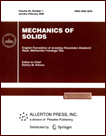 | | Mechanics of Solids
A Journal of Russian Academy of Sciences | | Founded
in January 1966
Issued 6 times a year
Print ISSN 0025-6544
Online ISSN 1934-7936 |
Archive of Issues
| Total articles in the database: | | 13362 |
| In Russian (»Á‚. –ņÕ. Ő““): | | 8178
|
| In English (Mech. Solids): | | 5184 |
|
| << Previous article | Volume 60, Issue 4 / 2025 | Next article >> |
| M.Y. Wu, Y.P. Mu, and F.S. Liang, "Kinematic Analysis and Spatial Simulation of Parallel Mechanism Comparators," Mech. Solids. 60 (4), 3205-3220 (2025) |
| Year |
2025 |
Volume |
60 |
Number |
4 |
Pages |
3205-3220 |
| DOI |
10.1134/S0025654425601569 |
| Title |
Kinematic Analysis and Spatial Simulation of Parallel Mechanism Comparators |
| Author(s) |
M.Y. Wu (School of Mechanical and Power Engineering, Harbin University of Science and Technology, Harbin, 150080 China;Key Laboratory of Advanced Manufacturing and Intelligent Technology, Ministry of Education, Harbin University of Science and Technology, Harbin, 150080 China, yunpeng2813@139.com)
Y.P. Mu (School of Mechanical and Power Engineering, Harbin University of Science and Technology, Harbin, 150080 China; Key Laboratory of Advanced Manufacturing and Intelligent Technology, Ministry of Education, Harbin University of Science and Technology, Harbin, 150080 China)
F.S. Liang (School of Mechanical and Power Engineering, Harbin University of Science and Technology, Harbin, 150080 China;Key Laboratory of Advanced Manufacturing and Intelligent Technology, Ministry of Education, Harbin University of Science and Technology, Harbin, 150080 China) |
| Abstract |
Traditional three-axis coordinate measuring machines often face limitations in measurement efficiency, hindering their application in high-speed manufacturing environments. This study
proposes a novel comparator design based on a parallel mechanism, aiming to enhance measurement
speed and precision in geometric inspection tasks. A comprehensive kinematic analysis and spatial
simulation of the proposed parallel mechanism comparator were conducted to validate its performance advantages. Initially, a detailed model of the parallel mechanism comparator was established,
accompanied by the construction of a spatial coordinate system. Utilizing screw theory, the mechanismís degrees of freedom were rigorously analyzed to ensure optimal mobility and constraint conditions. Subsequently, inverse kinematic equations were derived, enabling the computational filtering of
coordinate points that satisfy system constraints. The workspace of the mechanism was then mapped,
with particular emphasis on investigating the influence of motor stroke length on the reachable spatial volume. Finally, kinematic simulations of the actuator-driven parallel mechanism were performed to
assess output stability and dynamic behavior. The results demonstrate that the designed parallel mechanism comparator achieves an extensive workspace and exhibits stable actuator performance, confirming its potential to significantly improve measurement efficiency. This work not only provides a
theoretical foundation for high-speed, high-precision geometric inspection but also suggests promising applications of parallel mechanisms in the medical diagnostics field as a key enabling technology. |
| Keywords |
parallel mechanism comparator, degrees of freedom, kinematics, workspace, dynamics simulation |
| Received |
05 April 2025 | Revised |
30 May 2025 | Accepted |
11 June 2025 |
| Link to Fulltext |
|
| << Previous article | Volume 60, Issue 4 / 2025 | Next article >> |
|
 If you find a misprint on a webpage, please help us correct it promptly - just highlight and press Ctrl+Enter If you find a misprint on a webpage, please help us correct it promptly - just highlight and press Ctrl+Enter
|
|

 Russian
Russian  English
English